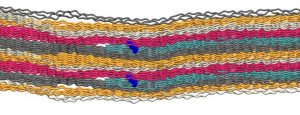Colbuilder

Collagen is the most abundant protein of our body, and yet, we know surprisingly little about its atomistic structure. In an integrative modelling approach, we have constructed atomistic models of collagen type I fibril structures. We make those models publically available for varying species and varying crosslinking types as they occur across different tissues. They can serve for inspecting binding sites, mutations or as input for modelling. We also provide ready-to-use force fields for Molecular Dynamics simulations.
Check out our repository here.